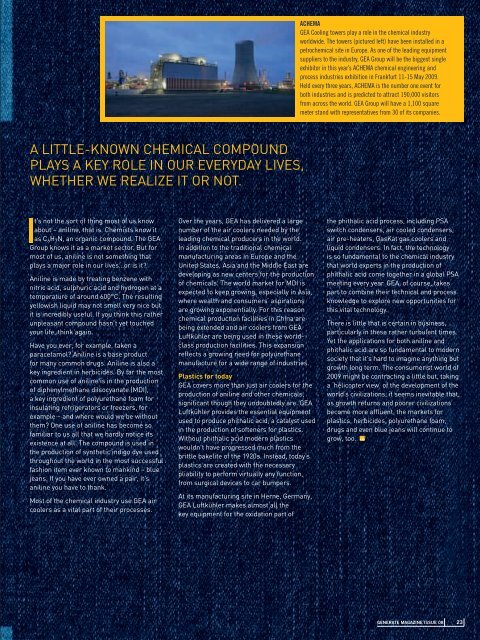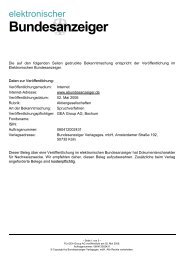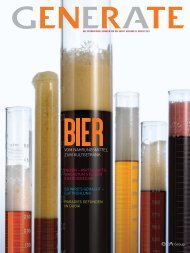PDF (10.0 MB) - GEA Group
PDF (10.0 MB) - GEA Group
PDF (10.0 MB) - GEA Group
You also want an ePaper? Increase the reach of your titles
YUMPU automatically turns print PDFs into web optimized ePapers that Google loves.
ACHEMA<br />
<strong>GEA</strong> Cooling towers play a role in the chemical industry<br />
worldwide. The towers (pictured left) have been installed in a<br />
petrochemical site in Europe. As one of the leading equipment<br />
suppliers to the industry, <strong>GEA</strong> <strong>Group</strong> will be the biggest single<br />
exhibitor in this year’s Achema chemical engineering and<br />
process industries exhibition in Frankfurt 11-15 May 2009.<br />
Held every three years, ACHEMA is the number one event for<br />
both industries and is predicted to attract 190,000 visitors<br />
from across the world. <strong>GEA</strong> <strong>Group</strong> will have a 1,100 square<br />
meter stand with representatives from 30 of its companies.<br />
A little-known chemical compound<br />
plays a key role in our everyday lives,<br />
whether we realize it or not.<br />
t’s not the sort of thing most of us know<br />
about – aniline, that is. Chemists know it<br />
as C 6 H 7 N, an organic compound. The <strong>GEA</strong><br />
<strong>Group</strong> knows it as a market sector. But for<br />
most of us, aniline is not something that<br />
plays a major role in our lives…or is it?<br />
Aniline is made by treating benzene with<br />
nitric acid, sulphuric acid and hydrogen at a<br />
temperature of around 600°C. The resulting<br />
yellowish liquid may not smell very nice but<br />
it is incredibly useful. If you think this rather<br />
unpleasant compound hasn’t yet touched<br />
your life, think again.<br />
Have you ever, for example, taken a<br />
paracetamol? Aniline is a base product<br />
for many common drugs. Aniline is also a<br />
key ingredient in herbicides. By far the most<br />
common use of aniline is in the production<br />
of diphenylmethane diisocyanate (MDI),<br />
a key ingredient of polyurethane foam for<br />
insulating refrigerators or freezers, for<br />
example – and where would we be without<br />
them? One use of aniline has become so<br />
familiar to us all that we hardly notice its<br />
existence at all. The compound is used in<br />
the production of synthetic indigo dye used<br />
throughout the world in the most successful<br />
fashion item ever known to mankind – blue<br />
jeans. If you have ever owned a pair, it’s<br />
aniline you have to thank.<br />
Most of the chemical industry use <strong>GEA</strong> air<br />
coolers as a vital part of their processes.<br />
Over the years, <strong>GEA</strong> has delivered a large<br />
number of the air coolers needed by the<br />
leading chemical producers in the world.<br />
In addition to the traditional chemical<br />
manufacturing areas in Europe and the<br />
United States, Asia and the Middle East are<br />
developing as new centers for the production<br />
of chemicals. The world market for MDI is<br />
expected to keep growing, especially in Asia,<br />
where wealth and consumers’ aspirations<br />
are growing exponentially. For this reason<br />
chemical production facilities in China are<br />
being extended and air coolers from <strong>GEA</strong><br />
Luftkühler are being used in these worldclass<br />
production facilities. This expansion<br />
reflects a growing need for polyurethane<br />
manufacture for a wide range of industries.<br />
Plastics for today<br />
<strong>GEA</strong> covers more than just air coolers for the<br />
production of aniline and other chemicals,<br />
significant though they undoubtedly are. <strong>GEA</strong><br />
Luftkühler provides the essential equipment<br />
used to produce phithalic acid, a catalyst used<br />
in the production of softeners for plastics.<br />
Without phithalic acid modern plastics<br />
wouldn’t have progressed much from the<br />
brittle bakelite of the 1920s. Instead, today’s<br />
plastics are created with the necessary<br />
pliability to perform virtually any function,<br />
from surgical devices to car bumpers.<br />
At its manufacturing site in Herne, Germany,<br />
<strong>GEA</strong> Luftkühler makes almost all the<br />
key equipment for the oxidation part of<br />
the phithalic acid process, including PSA<br />
switch condensers, air cooled condensers,<br />
air pre-heaters, GasKat gas coolers and<br />
liquid condensers. In fact, the technology<br />
is so fundamental to the chemical industry<br />
that world experts in the production of<br />
phithalic acid come together in a global PSA<br />
meeting every year. <strong>GEA</strong>, of course, takes<br />
part to combine their technical and process<br />
knowledge to explore new opportunities for<br />
this vital technology.<br />
There is little that is certain in business,<br />
particularly in these rather turbulent times.<br />
Yet the applications for both aniline and<br />
phithalic acid are so fundamental to modern<br />
society that it’s hard to imagine anything but<br />
growth long term. The consumerist world of<br />
2009 might be contracting a little but, taking<br />
a ‘helicopter view’ of the development of the<br />
world’s civilizations, it seems inevitable that,<br />
as growth returns and poorer civilizations<br />
become more affluent, the markets for<br />
plastics, herbicides, polyurethane foam,<br />
drugs and even blue jeans will continue to<br />
grow, too.<br />
GENERATE MAGAZINE ISSUE 08 23
















